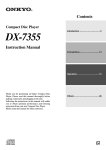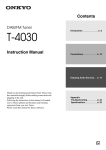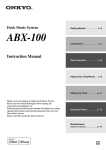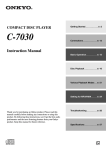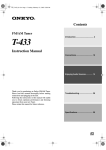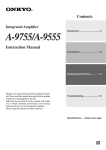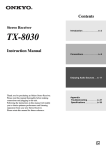Download ONKYO T-4355
Transcript
Contents AM/FM Tuner Introduction .................................... 2 T-4355 Instruction Manual Connections ................................. 10 Enjoying Audio Sources.............. 14 Thank you for purchasing an Onkyo AM/FM Tuner. Please read this manual thoroughly before making connections and plugging in the unit. Following the instructions in this manual will enable you to obtain optimum performance and listening enjoyment from your new Tuner. Please retain this manual for future reference. Troubleshooting ........................... 20 Specifications .............................. 21 En WARNING: TO REDUCE THE RISK OF FIRE OR ELECTRIC SHOCK, DO NOT EXPOSE THIS APPARATUS TO RAIN OR MOISTURE. CAUTION: TO REDUCE THE RISK OF ELECTRIC SHOCK, DO NOT REMOVE COVER (OR BACK). NO USER-SERVICEABLE PARTS INSIDE. REFER SERVICING TO QUALIFIED SERVICE PERSONNEL. WARNING AVIS RISK OF ELECTRIC SHOCK DO NOT OPEN RISQUE DE CHOC ELECTRIQUE NE PAS OUVRIR The lightning flash with arrowhead symbol, within an equilateral triangle, is intended to alert the user to the presence of uninsulated “dangerous voltage” within the product’s enclosure that may be of sufficient magnitude to constitute a risk of electric shock to persons. The exclamation point within an equilateral triangle is intended to alert the user to the presence of important operating and maintenance (servicing) instructions in the literature accompanying the appliance. Important Safety Instructions 1. 2. 3. 4. 5. 6. 7. 8. 9. 10. 11. 12. 13. 14. 2 Read these instructions. Keep these instructions. Heed all warnings. Follow all instructions. Do not use this apparatus near water. Clean only with dry cloth. Do not block any ventilation openings. Install in accordance with the manufacturer’s instructions. Do not install near any heat sources such as radiators, heat registers, stoves, or other apparatus (including amplifiers) that produce heat. Do not defeat the safety purpose of the polarized or grounding-type plug. A polarized plug has two blades with one wider than the other. A grounding type plug has two blades and a third grounding prong. The wide blade or the third prong are provided for your safety. If the provided plug does not fit into your outlet, consult an electrician for replacement of the obsolete outlet. Protect the power cord from being walked on or pinched particularly at plugs, convenience receptacles, and the point where they exit from the apparatus. Only use attachments/accessories specified by the manufacturer. Use only with the cart, stand, PORTABLE CART WARNING tripod, bracket, or table specified by the manufacturer, or sold with the apparatus. When a cart is used, use caution when moving the cart/apparatus combination to avoid injury from tip-over. S3125A Unplug this apparatus during lightning storms or when unused for long periods of time. Refer all servicing to qualified service personnel. Servicing is required when the apparatus has been damaged in any way, such as power-supply cord or plug is damaged, liquid has been spilled or objects have fallen into the apparatus, the apparatus has been exposed to rain or moisture, does not operate normally, or has been dropped. 15. Damage Requiring Service Unplug the apparatus from the wall outlet and refer servicing to qualified service personnel under the following conditions: A. When the power-supply cord or plug is damaged, B. If liquid has been spilled, or objects have fallen into the apparatus, C. If the apparatus has been exposed to rain or water, D. If the apparatus does not operate normally by following the operating instructions. Adjust only those controls that are covered by the operating instructions as an improper adjustment of other controls may result in damage and will often require extensive work by a qualified technician to restore the apparatus to its normal operation, E. If the apparatus has been dropped or damaged in any way, and F. When the apparatus exhibits a distinct change in performance this indicates a need for service. 16. Object and Liquid Entry Never push objects of any kind into the apparatus through openings as they may touch dangerous voltage points or short-out parts that could result in a fire or electric shock. The apparatus shall not be exposed to dripping or splashing and no objects filled with liquids, such as vases shall be placed on the apparatus. Don’t put candles or other burning objects on top of this unit. 17. Batteries Always consider the environmental issues and follow local regulations when disposing of batteries. 18. If you install the apparatus in a built-in installation, such as a bookcase or rack, ensure that there is adequate ventilation. Leave 20 cm (8") of free space at the top and sides and 10 cm (4") at the rear. The rear edge of the shelf or board above the apparatus shall be set 10 cm (4") away from the rear panel or wall, creating a fluelike gap for warm air to escape. Precautions 1. Recording Copyright—Unless it’s for personal use only, recording copyrighted material is illegal without the permission of the copyright holder. 2. AC Fuse—The AC fuse inside the unit is not userserviceable. If you cannot turn on the unit, contact your Onkyo dealer. 3. Care—Occasionally you should dust the unit all over with a soft cloth. For stubborn stains, use a soft cloth dampened with a weak solution of mild detergent and water. Dry the unit immediately afterwards with a clean cloth. Don’t use abrasive cloths, thinners, alcohol, or other chemical solvents, because they may damage the finish or remove the panel lettering. 4. Power WARNING BEFORE PLUGGING IN THE UNIT FOR THE FIRST TIME, READ THE FOLLOWING SECTION CAREFULLY. AC outlet voltages vary from country to country. Make sure that the voltage in your area meets the voltage requirements printed on the unit’s rear panel (e.g., AC 230 V, 50 Hz or AC 120 V, 60 Hz). The power cord plug is used to disconnect this unit from the AC power source. Make sure that the plug is readily operable (easily accessible) at all times. Some models have a voltage selector switch for compatibility with power systems around the world. Before you plug in such a model, make sure that the voltage selector is set to the correct voltage for your area. 5. Never Touch this Unit with Wet Hands—Never handle this unit or its power cord while your hands are wet or damp. If water or any other liquid gets inside this unit, have it checked by your Onkyo dealer. 6. Handling Notes • If you need to transport this unit, use the original packaging to pack it how it was when you originally bought it. • Do not leave rubber or plastic items on this unit for a long time, because they may leave marks on the case. • This unit’s top and rear panels may get warm after prolonged use. This is normal. • If you do not use this unit for a long time, it may not work properly the next time you turn it on, so be sure to use it occasionally. For British models Replacement and mounting of an AC plug on the power supply cord of this unit should be performed only by qualified service personnel. IMPORTANT The wires in the mains lead are coloured in accordance with the following code: Blue: Neutral Brown: Live As the colours of the wires in the mains lead of this apparatus may not correspond with the coloured markings identifying the terminals in your plug, proceed as follows: The wire which is coloured blue must be connected to the terminal which is marked with the letter N or coloured black. The wire which is coloured brown must be connected to the terminal which is marked with the letter L or coloured red. IMPORTANT The plug is fitted with an appropriate fuse. If the fuse needs to be replaced, the replacement fuse must approved by ASTA or BSI to BS1362 and have the same ampere rating as that indicated on the plug. Check for the ASTA mark or the BSI mark on the body of the fuse. If the power cord’s plug is not suitable for your socket outlets, cut it off and fit a suitable plug. Fit a suitable fuse in the plug. For European Models Declaration of Conformity We, ONKYO EUROPE ELECTRONICS GmbH LIEGNITZERSTRASSE 6, 82194 GROEBENZELL, GERMANY declare in own responsibility, that the ONKYO product described in this instruction manual is in compliance with the corresponding technical standards such as EN60065, EN55013, EN55020 and EN61000-3-2, -3-3. GROEBENZELL, GERMANY K. MIYAGI ONKYO EUROPE ELECTRONICS GmbH 3 Features Before Using this Unit ❑ ❑ ❑ ❑ ❑ ❑ ❑ ❑ • Turn off the power before changing the switch settings. • On changing the switch settings, T-4355 is initialized to its factory defaults. Radio presets and other settings are deleted. 30 AM/FM Presets Automatic AM/FM Scan Tuning Selectable Character Display RDS (PS/RT) (European models only) Audiophile-Grade Capacitor Hi-Rigidity, Anti-Resonant Chassis Aluminium Front Panel RI Remote Compatible Supplied Accessories Make sure you have the following accessories: Audio cable (80 cm) Setting the AM Tuning Step Frequency (Worldwide models only) cable (80 cm) To use , the T-4355 must be connected with an cable and an audio cable. Worldwide models are equipped with a switch that controls the AM band tuning steps. Please set this switch to match the AM band tuning step frequency in your area. USA: Set this switch to USA when T-4355 is used in the 10 kHz tuning step area. North America is the major area using the 10 kHz step frequency. OTHER: Set this switch to OTHER when T-4355 is used in the 9 kHz tuning step area. Indoor FM antenna Setting the Voltage Selector (Worldwide models only) AM loop antenna In catalogs and on packaging, the letter added to the end of the product name indicates the color of the T-4355. Specifications and operation are the same regardless of color. 4 Worldwide models are equipped with a voltage selector to conform with local power supplies.Be sure to set this switch to match the voltage of the power supply in your area before plugging in the unit. Determine the proper voltage for your area: 220-240 V or 120 V. If the preset voltage is not correct for your area, insert a screwdriver into the groove in the switch. Slide the switch all the way to the right (120 V) or to the left (220-240 V), whichever is appropriate. Table of Contents Introduction Important Safety Instructions.....................................................................................2 Precautions..................................................................................................................3 Features .......................................................................................................................4 Supplied Accessories .................................................................................................4 Before Using this Unit.................................................................................................4 Setting the AM Tuning Step Frequency (Worldwide models only) ........................4 Setting the Voltage Selector (Worldwide models only)..........................................4 Table of Contents ........................................................................................................5 Front & Rear Panels ....................................................................................................6 Front Panel ............................................................................................................6 Display...................................................................................................................7 Rear Panel.............................................................................................................7 Remote Controller .......................................................................................................8 RC-627S Remote Controller (supplied with the A-9355/A-9155 Integrated Amplifier) ............................................................................................................8 Using the Remote Controller .................................................................................9 Connections Connecting the T-4355 ..............................................................................................10 Connecting an amplifier.......................................................................................10 About the System Functions................................................................................11 Connecting Antennas ...............................................................................................12 Connecting the Indoor FM Antenna.....................................................................12 Connecting the AM Loop Antenna.......................................................................12 Connecting an Outdoor FM Antenna...................................................................13 Connecting an Outdoor AM Antenna...................................................................13 Enjoying Audio Sources Turning On the T-4355 ..............................................................................................14 Listening to the Radio...............................................................................................14 Tuning into Radio Stations Manually ...................................................................14 Presetting All Stations Automatically (Auto Preset).............................................15 Presetting Stations Manually ...............................................................................15 Selecting Preset Stations ....................................................................................16 Naming Presets ...................................................................................................17 Deleting Presets ..................................................................................................18 Displaying Information .........................................................................................18 FM Mode .............................................................................................................18 Tuner Operation with the RC-627S Remote Controller (supplied with the A-9355/A-9155)................................................................................................18 Using RDS (European models only)....................................................................19 Others Troubleshooting ........................................................................................................20 Specifications ............................................................................................................21 5 Front & Rear Panels Front Panel For detailed information, refer to the pages in parentheses. POWER switch (14) This switch is used to turn on/off the T-4355. DISPLAY button (18) This button is used to view various information on the display. TUNING [ ]/[ ] buttons (14) These buttons are used to tune into radio stations. They’re also used when setting the naming presets. MEMORY button (14) This button is used to store and delete presets. 6 FM MODE button (18) This button is used to set the FM mode to stereo or mono. Display See next page. BAND button (14) This button is used to select the FM or AM band. PRESET [ ]/[ ] buttons (14) These buttons are used to select presets. They’re also used when setting the naming presets. Front & Rear Panels—Continued Display MEM (Memory) indicator RDS indicator (European models only) This indicator lights up when storing radio presets. AUTO indicator This indicator lights up when the FM mode is Auto Stereo. /FM ST indicators These indicators show the status of the radio reception. This indicator lights up when tuned to an FM station that supports RDS. Message area Various information is displayed here, including preset number, tuning frequency, preset name, and so on. Rear Panel For detailed information, refer to the pages in parentheses. ANALOG AUDIO OUTPUT (10) These output jacks should be connected to an analog audio input on the amplifier by using the supplied audio cable. REMOTE CONTROL (11) These two identical (Remote Interactive) jacks can be connected to the jacks on your other Onkyo components for interactive control. To use , the T-4355 must be connected with an cable and an audio cable. AM ANTENNA (12) FM ANTENNA (75:) (12) This jack is for connecting the supplied indoor FM antenna or an outdoor FM antenna. FREQ. STEP switch (4) For Worldwide models only. VOLTAGE SELECTOR switch (4) For Worldwide models only. Power cord (14) The power cord should be connected to a suitable power source. These push terminals are for connecting the supplied AM loop antenna or an outdoor AM antenna. See pages 10–13 for connection information. 7 Remote Controller RC-627S Remote Controller (supplied with the A-9355/A-9155 Integrated Amplifier) BAND button (14) This button can be used to select the FM or AM band. If the T-4355 and A-9355/A-9155 are connected with an cable, pressing this button while the entire system is on Standby will turn on only the T-4355 and A-9355/A-9155. All other components will remain on Standby. FM MODE button (18) This button can be used to set the FM mode to stereo or mono. PRESET [+]/[–] buttons (18) When the input source on the A-9355/A-9155 is set to TUNER, these buttons can be used to select presets. TUNING [ ]/[ ] buttons (18) When the input source on the A-9355/A-9155 is set to TUNER, these buttons can be used to tune into stations. * Any remote controller for Onkyo amplifier is available to control T-4355 in a condition of the connection. (On some remote controllers, some buttons shown in the figure are missing. The corresponding functions cannot be controlled by the remote controller.) 8 Remote Controller—Continued Using the Remote Controller The T-4355 doesn’t have its own remote controller, but it can be controlled by using the RC-627S remote controller that’s supplied with the Onkyo A-9355/A-9155 Integrated Amplifier. The T-4355 and A-9355/A-9155 must be connected with an cable and an audio cable for this to work. When controlling the T-4355 with the A-9355/A-9155’s remote controller, point the controller at the A-9355/A-9155’s remote control sensor, as shown. Remote control sensor POWER ON OFF PHONES A SPEAKERS PHONO B OFF BASS OFF CD TUNER TREBLE MD STANDBY TAPE ON ON DOCK MUTING PURE DIRECT T-4355 A-9355/A-9155 30˚ LOUDNESS 30˚ 5m RC-627S Notes: • The remote controller may not work reliably if the A-9355/A-9155 is subjected to bright light, such as direct sunlight or inverter-type fluorescent lights. Keep this in mind when installing. • If another remote controller of the same type is used in the same room, or the A-9355/A-9155 is installed close to equipment that uses infrared rays, the remote controller may not work reliably. • Don’t put anything, such as a book, on the remote controller, because the buttons may be pressed inadvertently, thereby draining the batteries. • The remote controller may not work reliably if the A-9355/A-9155 is installed in a rack behind colored glass doors. Keep this in mind when installing. • The remote controller will not work if there’s an obstacle between it and the A-9355/A-9155’s remote control sensor. 9 Connecting the T-4355 Before Making Any Connections RCA Audio Connection Color Coding • Refer to the instructions that came with the component you are connecting. • Do not plug in the power cord until all other connections are complete. • Do not bind audio cables with power cords and speaker cables. Doing so may adversely affect the sound quality. • To prevent interference, keep power cords and speaker cables as far away as possible from the tuner’s antennas. • Red connectors are used for the right channel, and white connectors are used for the left channel. Left (white) L Right (red) R • Push each plug in all the way to make a good connection (loose connections can cause noise or malfunctions). Right! Wrong! Connecting an amplifier Use the supplied audio cable to connect the T-4355’s ANALOG AUDIO OUTPUT L/R jacks to the analog input jacks on the amplifier, as shown. To use the system functions, use the supplied cable to make an connection. T-4355 Supplied audio cable Supplied cable L CD PHONO MD TUNER TAPE DOCK BASS POWER R ON TREBLE A SPEAKERS B OFF PHONES PURE DIRECT OFF OFF ON ON LOUDNESS MUTING STANDBY TUNER Amplifier Notes: • The T-4355 has two jacks. They’re both the same, so you can use either one. • To use , you must make an audio connection between the T-4355 and the other component. • Use only dedicated cables for connections. • If the T-4355 is used with another Onkyo component, such as the A-9355/A-9155, refer to its instruction manual as well. 10 Connecting the T-4355—Continued About the System Functions If you connect the T-4355 to another Onkyo -capable component with the supplied cable and audio cable, you can use the following system functions. cables are special cables solely for use with Onkyo products. Direct Change When you select a radio preset or change the band (AM, FM), your Onkyo amplifier will automatically select the T-4355 as the input source. Remote Control Operation You can control the T-4355 by using your Onkyo amplifier’s remote controller. See the amplifier’s instruction manual for details. Notes: • Push each plug in all the way to make a good connection. • Use only dedicated cables for connections. cables are supplied with Onkyo tuners and players (DVD, CD, etc.). • Some components, including the T-4355, have two jacks. They're both the same, so use either one. • jacks should be connected only to Onkyo components. Connecting them to another manufacturer's component may cause a malfunction. • Some components may not support all functions. See the manuals supplied with your other Onkyo components for more information. With (Remote Interactive), you can control your -capable Onkyo CD player, T-4355, and so on with your amplifier’s remote controller. • To use , you must make an analog audio connection between your amplifier and each audio component. Onkyo amplifier (A-9355), etc. jack Onkyo CD player (DX-7355), etc. jack T-4355 jack Remote Interactive Dock, etc. cable 11 Connecting Antennas This section explains how to connect the supplied indoor FM antenna and AM loop antenna and how to connect commercially available outdoor FM and AM antennas. AM antenna push terminals Connecting the AM Loop Antenna The supplied indoor AM loop antenna is for indoor use only. 1 Assemble the AM loop antenna, inserting the tabs into the base, as shown. 2 Connect both wires of the AM loop antenna to the AM push terminals, as shown. The antenna connection is polarity sensitive. Connect the black wire to the ground terminal ( ). Connect the other wire to the other terminal. Make sure that the wires are attached securely and that the push terminals are gripping the bare wires, not the insulation. FM antenna jack Connecting the Indoor FM Antenna The supplied indoor FM antenna is for indoor use only. 1 Attach the FM antenna, as shown. Insert the plug fully into the jack. Once your T-4355 is ready for use, you’ll need to tune into an FM radio station and adjust the position of the FM antenna to achieve the best possible reception. 2 Push Insert wire Release Use thumbtacks or something similar to fix the FM antenna into position. Black Thumbtacks, etc. Caution: Be careful that you don’t injure yourself when using thumbtacks. If you cannot achieve good reception with the supplied indoor FM antenna, try using a commercially available outdoor FM antenna instead. 12 Once your T-4355 is ready for use, you’ll need to tune into an AM radio station and adjust the position of the AM antenna to achieve the best possible reception. Keep the antenna as far away as possible from your T-4355, TV, speaker cables, and power cords. If you cannot achieve good reception with the supplied indoor AM loop antenna, try using it with a commercially available outdoor AM antenna. Connecting Antennas—Continued Connecting an Outdoor FM Antenna Connecting an Outdoor AM Antenna If you cannot achieve good reception with the supplied indoor FM antenna, try using a commercially available outdoor FM antenna instead. If good reception cannot be achieved using the supplied AM loop antenna, an outdoor AM antenna can be used in addition to the loop antenna, as shown. Outdoor antenna Insulated antenna cable AM loop antenna White Antenna adapter (not included) Notes: • Outdoor FM antennas work best outside, but acceptable results can sometimes be obtained when installed in an attic or loft. • For best results, install the outdoor FM antenna well away from tall buildings, preferably with a clear line of sight to your local FM transmitter. • Outdoor antenna should be located away from possible noise sources, such as neon signs, busy roads, etc. • For safety reasons, outdoor antenna should be situated well away from power lines and other high voltage equipment. • Outdoor antenna must be grounded in accordance with local regulations to prevent electrical shock hazards. Black Outdoor AM antennas work best when installed outside horizontally, but good results can sometimes be obtained indoors by mounting horizontally above a window. Note that the AM loop antenna should be left connected. Outdoor antenna must be grounded in accordance with local regulations to prevent electrical shock hazards. Using a TV/FM Antenna Splitter It’s best not to use the same antenna for both FM and TV reception, as this can cause interference problems. If circumstances demand it, use a TV/FM antenna splitter, as shown. TV/FM antenna splitter To T-4355 To TV (or VCR) 13 Turning On the T-4355 Listening to the Radio Tuning into Radio Stations Manually POWER TUNING 1 Plug the power cord into a suitable wall outlet (or the AC OUTLET on the A-9355/A-9155’s rear panel). 2 Press the T-4355’s [POWER] switch. The T-4355 turns on. To turn off the T-4355, press the [POWER] switch. Using the A-9355/A-9155’s Remote Controller ON RC-627S (remote controller supplied with the A-9355/A-9155) If you’re using the T-4355 together with the A-9355/A-9155 Onkyo amplifier, press the remote controller’s [ON] button to turn on the T-4355 and A-9355/A-9155. (Plug the T-4355 power cord into the A-9355/A-9155 AC OUTLET.) Memory backup The T-4355 uses a battery-less memory backup system in order to retain radio presets and other settings when it’s unplugged or in the case of a power failure. Backup data can be stored incorrectly or destructed, and lead to a malfunction if either of the following operations is performed: • turning off the power immediately after an operation. • repeating the fast power on/off switchings. When a malfunction occurred due to those operations, initialize T-4355 to its factory defaults. Radio presets and other settings are deleted. To initialize T-4355, press the [DISPLAY] button while holding down the [FM MODE] button. When the power is turned off while the Auto Preset is running, T-4355 is initialized to its factory defaults. 14 BAND 1 Use the [BAND] button to select FM or AM. The band switches between FM and AM each time you press the button. 2 Use the TUNING [ ]/[ ] buttons to tune into a station. The tuning frequency is shown on the display. For each button press, the frequency will change in 0.05 MHz steps for FM, and 9 kHz steps for AM. If you hold down the button for more than 0.5 second, the T-4355 will find the next station automatically. Listening to the Radio—Continued You can store up to 30 of your favorite radio stations as presets for quick selection. Stations can be preset automatically using the Auto Preset function or manually. Notes: • You can preset up to 30 AM/FM stations. If you try to store more than this, the message “FULL” will appear on the display. • Using the remote controller while listening to an AM radio station may cause interference. Presetting All Stations Automatically (Auto Preset) With the Auto Preset function, you can search and store all of the radio stations available in your area in one go. Notes: • All existing presets will be replaced when the Auto Preset function is used. • Be sure that your antennas are positioned so as to obtain the best possible reception (see page 12). Presetting Stations Manually Here you can tune into stations individually and store them as presets. This allows you to store stations in any order you like. Notes: • You can store up to 30 stations, and this can be any combination of FM and AM stations. For example, 17 FM stations and 13 AM stations, or 8 FM stations and 22 AM stations. • Although the numbering schemes for FM and AM presets both start at 1, it doesn’t matter because FM and AM presets are selected independently. • Stations can be stored to presets in any order. For example, you could store some AM stations to presets 2, 1, 9, and so on. TUNING MEMORY BAND 1 Press and hold the [MEMORY] button for about 5 seconds until auto tuning starts. When the [MEMORY] button is pressed, first, the MEM indicator flashes. Next, “AUTO PRESET” flashes on the display, followed by the tuning frequency, and then auto tuning starts. When a station is found, auto tuning stops and the indicator lights up. Starting at the bottom of the frequency band, the T-4355 automatically tunes and stores up to 20 FM stations, then up to 10 AM stations. MEMORY PRESET Use the [BAND] button to select FM or AM. The band switches between FM and AM each time you press the button. 2 Press the TUNING [ ]/[ ] buttons for 1 second until auto tuning starts. The frequency display changes during auto tuning. Auto tuning stops when a station is found. Note: Depending on your location, a preset may be stored with no station and you’ll hear only noise when you select it. In this case, delete the preset (see page 18). 15 Listening to the Radio—Continued 3 Press the [MEMORY] button. MEM indicator The MEM indicator appears and the preset number flashes. If you don’t complete the next step within 8 seconds, the T-4355 will return to the previous condition and the MEM indicator will disappear. Note: Be careful not to press the [MEMORY] button for too long because “AUTO PRESET” will flash on the display and the Auto Preset function will begin, replacing all of your previously stored presets. 4 Use the PRESET [ ]/[ ] buttons to select a preset number from 1 through 30. 5 Press the [MEMORY] button again to store the station. The station is stored, the preset number stops flashing, and the MEM indicator disappears. Repeat this procedure for all your favorite radio stations. Note: If you store a station to a preset that already had a station stored in it, the previous station will be replaced. After Storing Presets You Can • Select them and enjoy your favorite stations. • Name them for easy identification (see page 17). • Delete them (see page 17). 16 Selecting Preset Stations You must store some presets before you can select them (see page 15). BAND PRESET Before proceeding, turn on the T-4355. 1 Use the [BAND] button to select FM or AM. The band switches between FM and AM each time you press the button. 2 Use the PRESET [ ]/[ ] buttons to select a preset. Press the Down [ ] button to select the previous preset. Press the Up [ ] button to select the next preset. The number of the currently selected preset is shown on the display. Listening to the Radio—Continued Correcting Characters Naming Presets Radio presets can be named for easy identification, and names may contain up to 8 characters from the following selection. If Name Edit mode is not selected, follow steps 1 and 2 in the left column. DISPLAY TUNING _ABCDEFGHIJKLMNOPQRSTUVW XYZ abcdefghijklmnopqrstuvwxyz "'&()[]*+,-./=?0123456789 PRESET The underscore (_) character is actually a space. DISPLAY MEMORY 1 Use the TUNING [ ]/[ ] buttons to select the character to edit. 2 Use the PRESET [ ]/[ ] buttons to change the character. 3 Press the [DISPLAY] button to store the name and exit Name Edit mode. PRESET 1 Select the preset that you want to name. See page 16 for selecting presets. 2 Press and hold down the [DISPLAY] button for 3 seconds to select Name Edit mode. The cursor appears on the display. 3 4 5 Use the PRESET [ ]/[ ] buttons to select the characters. Note: Text editing features such as moving subsequent characters to the right when a new character is inserted, or moving subsequent characters to the left when a character is deleted are not supported. Press the [MEMORY] button to set the character. The cursor moves to the next character. Repeat steps 3 and 4 to enter the other characters. Press the [DISPLAY] button when you’ve finished. The radio frequency reappears on the display. Deleting All Characters in One Go If Name Edit mode is not selected, follow steps 1 and 2 in the left column. MEMORY FM MODE CLEAR Hints: • To cancel the naming process without storing the name, press the [MEMORY] button. • After the eighth character has been entered, pressing the [MEMORY] button will move the cursor back to the first character. While holding down the [MEMORY] button, press the [FM MODE] button. Note: Make sure that Name Edit mode is selected before doing this because if it isn’t, the current preset will be deleted instead. 17 Listening to the Radio—Continued Deleting Presets Individual presets can be deleted as follows. 1 Select the preset that you want to delete. See page 16 for selecting presets. 2 While holding down the [MEMORY] button, press the [FM MODE] button. The preset number on the display disappears and the preset is deleted. MEMORY FM MODE CLEAR FM Mode In places where the signal strength is weak or reception is noisy, press the [FM MODE] button to listen in mono (AUTO indicator off). This will reduce the noise and any break up in reception. To return to stereo, press the [FM MODE] button again (AUTO indicator on). Tuner Operation with the RC-627S Remote Controller (supplied with the A-9355/A-9155) Displaying Information By pressing the T-4355’s [DISPLAY] button repeatedly, you can view the tuning frequency or text (preset name or RDS). Frequency Text (preset name or RDS) Note: If the current preset doesn’t have a name, no text will be displayed. Selecting FM or AM This button can be used to select FM or AM. Selecting Radio Presets Press the Down [–] button to select the previous preset. Press the Up [+] button to select the next preset. Setting FM mode This button can be used to set the FM mode to stereo or mono. Tuning Manually Press the Down [ ] button to decrease the tuning frequency. Press the Up [ ] button to increase the tuning frequency. Note: If you’re using another Onkyo amplifier’s remote controller, refer to its instruction manual for operating information. 18 Listening to the Radio—Continued Using RDS (European models only) RDS stands for Radio Data System and is a method of transmitting data in FM radio signals. Many FM stations use it these days. The T-4355 supports the following types of RDS data: PS: Program Service Name When tuned to an RDS station that’s broadcasting PS information, the station’s name appears on the display. RT: Radio Text When tuned to an RDS station that’s broadcasting RT text information, the text scrolls across the display. Note: If the signal from an RDS station is weak, RDS data maybe displayed intermittently or not at all. Displaying RDS information Note: You must be tuned to an FM station that supports RT (Radio Text) in order to display any text. DISPLAY Press the [DISPLAY] button repeatedly to show the following information. Frequency Preset name or PS (Program Service name) RT (Radio Text) Notes: • If the current station does not support RDS, only the frequency and preset name (see page 17) will be displayed. If the current preset has no name, only the frequency will be displayed. • In some cases, it may take between 2 and 15 seconds for the RT text to be displayed. • The message “Waiting···” may appear while the RT data is being received. • When tuned to an RDS station that’s not transmitting any RT data, the message “No Text” will be displayed. 19 Troubleshooting If you have any trouble using the T-4355, look for a solution here. If you can’t resolve the issue yourself, contact your Onkyo dealer. Power Can’t turn on the T-4355. • Make sure that the power cord is properly plugged into the wall outlet (page 14). • Unplug the power cord from the wall outlet, wait five seconds or more, then plug it in again. Audio There’s no sound. • The T-4355 is not connected properly. Check all connections and correct as necessary. • The wrong input source is selected on your amplifier. Check your amplifier’s input source setting. Refer to your amplifier’s manual. • Make sure the amplifier’s volume control is not set to minimum. Radio Reception is noisy, stereo FM reception suffers from hiss, the Auto Preset function doesn’t preset all stations, or the ST indicator doesn’t light up when tuned to a stereo FM station. • Check the antenna connections. • Change the position of the antenna. • Move the T-4355 away from a nearby TV or computer. • Move power cords and speaker cables as far away as possible from the tuner’s antenna. • Cars or airplanes can cause noisy interference. • The radio signal will be weakened if it has to pass through a concrete wall before reaching the antenna. • Try setting FM mode to mono. • When listening to an AM station, noise may be heard when you operate the remote controller. • If none of the above improves the reception, install an outdoor antenna. Settings such as radio presets were deleted. • Backup data can be stored incorrectly or destructed, and lead to a malfunction if either of the following operations is performed: - turning off the power immediately after an operation. - repeating the fast power on/off switchings. • When a malfunction occurred due to those operations, initialize T-4355 to its factory defaults (see below), then set radio presets or other settings again. Remote Controller The A-9355/A-9155’s remote controller doesn’t work. • Point the remote controller at the A-9355/A-9155’s remote sensor (page 9). • To use , you must make an connection and an audio connection between the A-9355/A-9155 and T-4355 (page 11). The T-4355 contains a microcomputer for signal processing and control functions. In very rare situations, severe interference, noise from an external source, or static electricity may cause it to lockup. In the unlikely event that this should happen, unplug the power cord, wait at least five seconds, and then plug it again. To reset the T-4355 to its factory defaults, turn it on and, while holding down the [FM MODE] button, press the [DISPLAY] button. “CLEAR” will appear on the display. 20 Specifications FM Tuning frequency range: Usable sensitivity: SN ratio: THD (total harmonic distortion): Frequency response: Stereo separation: AM Tuning frequency range: Usable sensitivity: SN ratio: THD (total harmonic distortion): General Power supply: Power consumption: Dimensions (W u H u D): Weight: 87.50–108.00 MHz Stereo: 17.2 dBf 2.0 µV (75: IHF) Mono: 11.2 dBf 1.0 µV (75: IHF) Stereo: 70 dB (IHF-A) Mono: 76 dB (IHF-A) Stereo: 0.3% (1 kHz) Mono: 0.2% (1 kHz) 20 Hz–15 kHz / ±1.5 dB 45 dB (1 kHz) 522–1611 kHz 530–1710 kHz 30 µV 50 dB 0.7% European model: AC 20–230 V, 50/60 Hz Asian model: AC 10/220–240 V, 50/60 Hz European model: 9 W Asian model: 10 W 435 u 81 u 310 mm 17-1/8s u 3-3/16s u 12-3/16s 3.2 kg 7.1 lbs. Specifications and features are subject to change without notice. 21 Memo 22 Memo 23 Sales & Product Planning Div. : 2-1, Nisshin-cho, Neyagawa-shi, OSAKA 572-8540, JAPAN Tel: 072-831-8023 Fax: 072-831-8124 ONKYO U.S.A. CORPORATION 18 Park Way, Upper Saddle River, N.J. 07458, U.S.A. Tel: 201-785-2600 Fax: 201-785-2650 http://www.us.onkyo.com/ ONKYO EUROPE ELECTRONICS GmbH Liegnitzerstrasse 6, 82194 Groebenzell, GERMANY Tel: +49-8142-4401-0 Fax: +49-8142-4401-555 http://www.eu.onkyo.com/ ONKYO EUROPE UK Office Suite 1, Gregories Court, Gregories Road, Beaconsfield, Buckinghamshire, HP9 1HQ UNITED KINGDOM Tel: +44-(0)1494-681515 Fax: +44(0)-1494-680452 ONKYO CHINA LIMITED Units 2102-2107, Metroplaza Tower I, 223 Hing Fong Road, Kwai Chung, N.T., HONG KONG Tel: 852-2429-3118 Fax: 852-2428-9039 http://www.ch.onkyo.com/ HOMEPAGE http://www.onkyo.com/ Y0702-2 SN 29344431A 24(C) Copyright 2007 ONKYO CORPORATION Japan. All rights reserved. * 2 9 3 4 4 4 3 1 A *
























